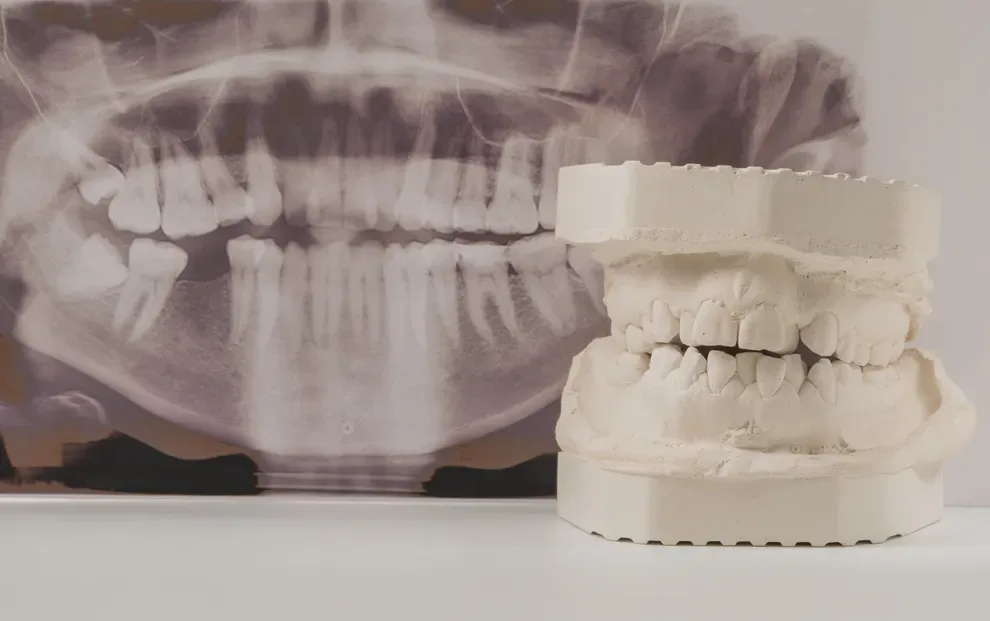How to Fix a Misaligned or Crooked Jaw

Table of Contents
- Key Facts
- Misaligned Jaw Appearance
- What Causes a Crooked Jaw?
- Treatment Options
- Is Treatment Mandatory?
- Aligners for Mild Cases
- Symptoms of a Crooked Jaw
- Types of Misalignment
- Trauma as a Cause for Crooked Jaw
- Misaligned Jaw FAQs
A misaligned or crooked jaw can affect one’s appearance, self-esteem, and oral and overall health. Jaw issues are a common cause of malocclusion, or teeth misalignment. Jaw misalignment may be a factor in malocclusion conditions that include underbite, overbite, crossbite, and open bite.
Most cases of jaw misalignment are caused by genetics. Other causes may include injury, congenital conditions, developmental problems, TMJ and tooth grinding, missing teeth, and childhood oral habits like pacifier use and thumb sucking.
Treatment for a misaligned jaw may include lost tooth replacement, braces, orthodontic devices like headgear and palatal expanders, and jaw (orthognathic) surgery. For the treatment of mild-to-moderate jaw misalignment and related malocclusion, clear removable aligners may also be a convenient option.
Key Facts about a Misaligned Jaw
A misaligned jaw occurs when the upper and lower jaw don’t line up to a correct bite when closed. This can cause (or be caused by) malocclusion, or teeth misalignment. Conditions related to a misaligned jaw include overbite, underbite, crossbite, and open bite.
Jaw misalignment is usually diagnosed and treated by an orthodontist. In severe cases, a jaw specialist or surgeon may be needed.
Jaw misalignment can lead to health problems that include tooth decay, gum disease, jaw pain, TMJ, sleep disorders, headaches, and difficulty speaking and eating. A crooked jaw can also lower self-esteem and affect mental health.
Jaw misalignment may be treated with surgery, orthodontic devices like headgear and palatal expanders, braces, or clear aligners.
What does a Misaligned Jaw Look Like?
How a misaligned jaw looks will vary greatly depending on the type of jaw misalignment and how severe the problem is.
Some cases of crooked jaw are very minor and not noticeable. Others are very prominent and have a serious impact on appearance.
In some cases, the upper jaw sits too far forward of the lower jaw. This is often related to overbite malocclusion conditions (class 2 malocclusions), including “buck teeth” or overjet teeth, in which the front teeth seem to protrude out over the lower teeth.
When the lower jaw juts in front of the upper jaw, it may be related to underbite malocclusions (class 3 malocclusions), in which the lower teeth and jaw overlap the upper teeth and jaw.
Symptoms of a Crooked Jaw
Some people notice a crooked jaw when they look in the mirror. Others also have physical signs and symptoms.
Common symptoms of a misaligned jaw include the following:
Aching jaw joints
Clicking or popping sounds when opening the mouth
Jaws that become blocked, so you can’t open wide
Advanced tooth decay, as it’s hard to clean properly
Worn-down teeth
A crooked jaw also requires the muscles in your head and neck to work harder than they should. That can lead to muscle spasm, headaches, sinus pain, and discomfort in the neck and shoulders.
Types of Misalignment
A crooked jaw can look different in different people. Doctors use a classification system to help their patients understand how serious the misalignment might be.
Doctors call misalignment malocclusion. In one classification system, six different types of them exist, including the following:
Class I: The upper teeth are slightly in front of their lower counterparts, and the jaw is aligned properly.
Class II: The upper teeth are far in front of the lower teeth, and the jaw is underdeveloped.
Class III: The lower teeth are in front of the upper teeth, and the jaw is overdeveloped.
Class IV: The front teeth are significantly behind the lower versions.
Class V: The front teeth are far in front of the lower teeth, and the jaw is overdeveloped.
Class VI: The lower teeth are far behind the upper teeth.
Your doctor can use visual examinations and measuring tools to determine where your smile fits into this classification system.
What Causes a Crooked Jaw?
Many jaw conditions are hereditary. Most cases of crooked jaw are simply due to genetics.
Jaw misalignment can also be caused by the following:
Injury or trauma to the mouth, teeth, or jaw
Prolonged thumb sucking or pacifier use as a child, especially if continued after permanent teeth came in
Teeth grinding
Tongue thrusting
TMJ (temporomandibular joint) disorders
Missing teeth that have caused remaining teeth to shift
Congenital problems
Developmental disorders
Trauma as a Cause for Crooked Jaw
While some people develop crooked jaw due to genetics or habits, others get the problem due to head trauma.
Researchers say common causes of head trauma include the following:
Car accidents
Falls
Assaults
If you break your jaw after an incident like this, it may not heal properly and cause a crooked jaw. Stretched ligaments and tendons caused by the trauma can also push your teeth out of alignment.
Your treatment options for a trauma-influenced crooked jaw depend on your injuries. Sometimes, people need surgery to fix the alignment issue and promote healing. In other cases, the misalignment can be addressed with physical therapy and massage. Your doctor can assess your injuries and help to develop a program that’s right for you.
Treatment for a Misaligned Jaw Varies by Age
Treatment for a misaligned jaw may be very different for children than it is for adults. Children and adolescents have jaws that are still developing. Therefore, their jaws are easier to influence with orthodontic devices and appliances.
Adults have developed (formed) jaws. Orthodontic devices may still be used in treatment, but they may be less effective and take longer.
Crooked Jaw Treatment for Growing Kids
When dealing with the still-forming jaws of children and adolescents, orthodontists may try to change the course of jaw development in order to correct a problematic bite. Devices like retainers, headgear (a banded device with wiring inside and outside of the mouth), and palatal expanders (which sit on the roof of the mouth and are expanded to widen the jaw) may be used. Retainers and palatal expanders may even be fixed to the mouth for maximum effectiveness.
Braces and aligners are also used to correct jaw issues and their related teeth misalignment. In severe cases, jaw surgery may be required.
This chart can help you understand who benefits from these typical treatments:
| Who Needs This Treatment? | How Effective Is It? |
Headgear | Children with misaligned jaws that can’t be treated with braces alone | Very effective when used with braces |
Palatal expanders | Children with misaligned jaws who are still growing | Very effective when followed with braces and aligners |
Braces | Children with significantly misaligned jaws that can’t be treated with aligners | Very effective, but can be uncomfortable to wear |
Aligners | Adolescents with mild to moderate cases of misaligned jaws | Very effective when worn as directed by a dental professional |
Crooked Jaw Treatment for Adults
Because the jaws of adults are already formed and harder to manipulate, orthodontic devices and appliances are less likely to be effective in treating very severe cases of jaw misalignment. Orthognathic (jaw) surgery may be the only option in these cases.
For less severe cases, braces and clear aligners may be used to correct a jaw misalignment.
For braces, brackets are cemented to the teeth and connected by wires. These wires are periodically tightened to apply pressure to reposition the teeth and jaw.
Orthodontic devices like palatal expanders are sometimes used along with braces.
Clear aligners also apply pressure to move the teeth and jaw into place, but they do it in a different way. Rather than being fixed to the teeth, aligners are removable, and they fit over teeth. They mimic your current bite but include subtle pressure points and changes that will shift your teeth.
With aligner treatment, you’ll transition through a series of aligner trays, wearing each one for a week or two before moving on to the next. Each tray gradually moves you closer to your ideal alignment. After your last tray, your smile will be ready.
This chart can help you understand who benefits from these typical treatments:
| Who Needs This Treatment? | How Effective Is It? |
Braces | People with significant crooked jaws that can’t be addressed by aligners | Very effective, but they can be uncomfortable to wear |
Aligners | People with mild to moderate misalignment | Very effective when worn as directed by a dental professional |
Palatal expanders | Adults with severely crooked jaws | Very effective, but they can be uncomfortable when worn by adults |
Surgery | People with severe misaligned jaw that can’t be treated via conventional treatments | Very effective, but the recovery can be slow and painful |
Is Treatment Mandatory?
An orthodontist will be able to tell you how severe your jaw misalignment is and how imperative treatment is. However, it’s important to remember that any jaw misalignment could lead to teeth misalignment and jaw strain. If left untreated, the problem may only get worse and harder to correct.
Aligners: A Great Option for Mild Cases
For mild-to-moderate cases of jaw misalignment, clear aligners may have many advantages over other types of treatment. Aligners are virtually invisible and removable, so they can be taken out to eat and perform your daily oral hygiene routine. Most aligners work faster than braces, with an average treatment time of 4–6 months.
Misaligned Jaw Frequently Asked Questions
Depending on how severe your jaw misalignment is, treatment options may include surgery, orthodontic appliances, braces, or aligners. If your misalignment is mild or moderate, you can take Byte’s 30-second assessment or order an at-home impression kit to find out if aligners would work for you (if you’re not a candidate for aligners, Byte will refund you).
Most misaligned jaws are caused by genetics and cannot be prevented. Sometimes misaligned jaws are caused by other issues, including teeth grinding, childhood thumb sucking and pacifier use, trauma and injury, teeth misalignment, missing teeth, congenital problems, and developmental issues.
In many cases, a misaligned jaw is visible. The upper jaw may appear to sit too far in front of the lower teeth, or the lower jaw may protrude forward. Other symptoms may include jaw pain, crooked or misaligned teeth, and speech and eating problems. A dentist will be able to identify a jaw misalignment and refer you to an orthodontist if needed.
In many cases, yes. While very serious cases of jaw misalignment will need surgery to be corrected, it’s more common that the condition can be treated with other treatments or a combination of other treatments, including tooth replacement, orthodontic devices, braces, and clear aligners.
While it’s possible that the jaw might correct itself over time, it’s not likely, and it’s less common in adulthood.
